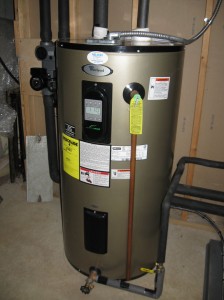Dear Jim: My 80-gallon electric water heater is getting old, but it does not leak. I imagine there are some things I can do to make it operate more efficiently. What improvements do you recommend? — Ron H.
Dear Ron: Heating water is one of the greatest contributors to your monthly utility bills. For a typical family of four, it is not unusual for water heating to consume 20 percent to 25 percent of the total annual energy use.
An electric water heater is basically a big, insulated tank of water with an upper and a lower resistance-heating element. The lower is the main element used. When most of the hot water has been consumed, the lower one goes off. The upper one then comes on to supply hot water more quickly since the water is drawn from the tank top.
Even if you do not use any hot water, the lower element will cycle on at times to make up for heat lost through the tank walls (called standby losses). Heat can also be lost through the tank’s piping, especially if the tank is without heat traps. Your older water heater likely just has a couple of inches of fiberglass insulation between the glass-lined metal tank and the external skin.
 Insulating the water tank
Insulating the water tank
Place the back of your hand against the water heater tank near or on the top. If it feels warm, it is losing heat, and adding an insulation wrap kit would be effective and save money. With a tall, 80-gallon tank, the insulation wrap may not reach all the way down to the floor. This is OK because the majority of the heat loss is from the upper part of the tank.
You can certainly install your own insulation, but a kit from a home improvement store is roughly $20, easy to install and includes instructions (get one with an insulating value of at least R-10). If you do it yourself, it is more important to tape and seal the joints in the insulation (where the insulation on the top meets the sides) to create an airtight barrier. Fiberglass insulation is only effective if you prevent air from passing through it.
Draining the tank
At least once a year, drain a gallon of water from the drain valve at the bottom of the tank to flush out sediment that insulates the water from the heating element.
Managing water temperature
It is important to keep the water temperature as low as possible. A greater temperature difference between the hot water and the air in your basement or utility room increases the tank standby losses.
Check the temperature of the hot water at a faucet where you use the most hot water. I keep the water temperature at my house at only 110 degrees. If you keep it so hot that you have to mix much cold with it to tolerate the temperature, it is too hot. Most laundry detergents work well in cold water, and dishwashers have built-in preheaters. Be sure to turn off electricity to the water heater before making any adjustments.
Feel the temperature of the hot-water outlet and cold-water inlet pipes. If they are fairly warm, it means hot water, because it is less dense, is naturally circulating upward and cooling off. Put tubular foam insulation on the first 4 to 6 inches of exposed water heater inlet and outlet pipes to minimize the heat loss.
Installing a timer
Installing a water heater timer can be effective if your work schedule means you typically do not use hot water during a longer regular time period. This keeps the heating elements from coming on. The temperature should not drop much on a well-insulated tank.
If you end up deciding to get a new electric water heater, select a 12-year-warranty model. These have higher R-value foam insulation in the tank walls than a cheaper six-year model. Also, most of the 12-year models have electronic digital controls, which simplify setting the hot water temperature and have a vacation-mode setting to save electricity when you travel.
Heat pump water heaters should also be considered if you’re looking to make a purchase. These water heaters use electricity to move heat from one place to another rather than generating heat directly. While they tend to cost more initially, their lower operating costs can save you money in the long run.


